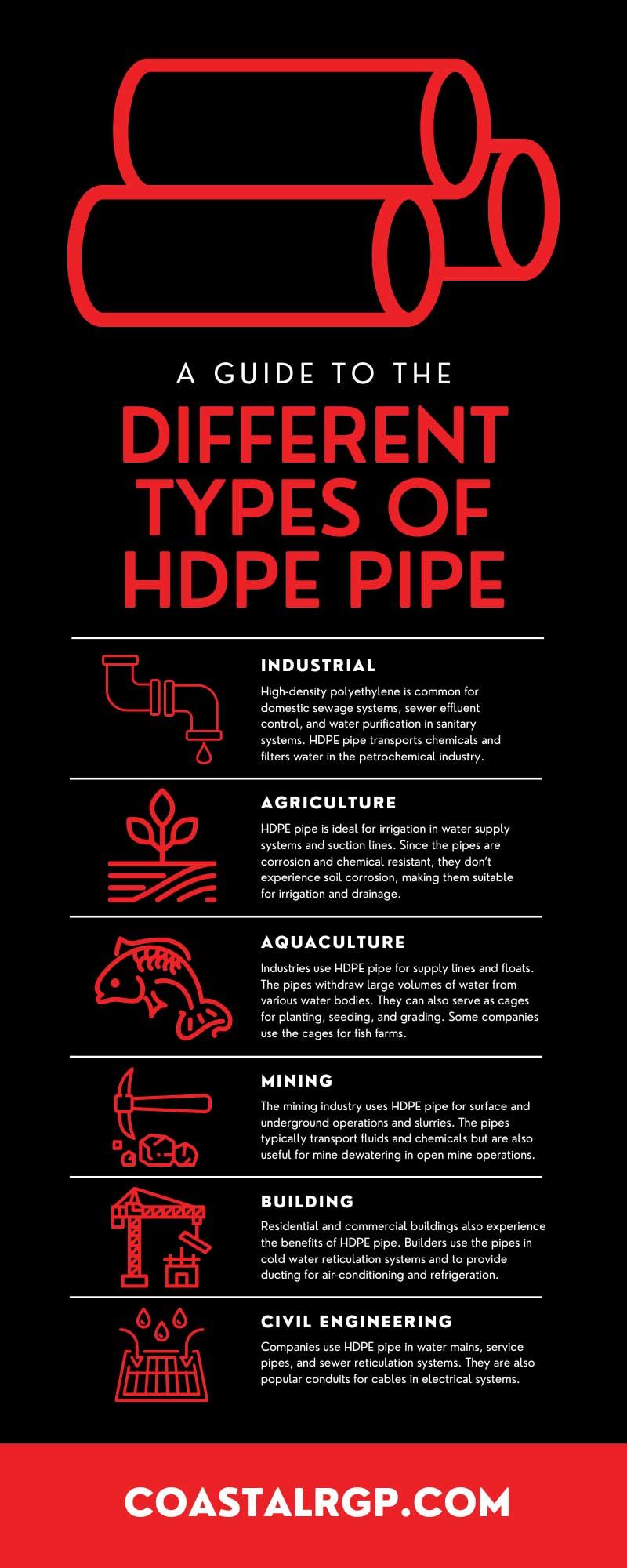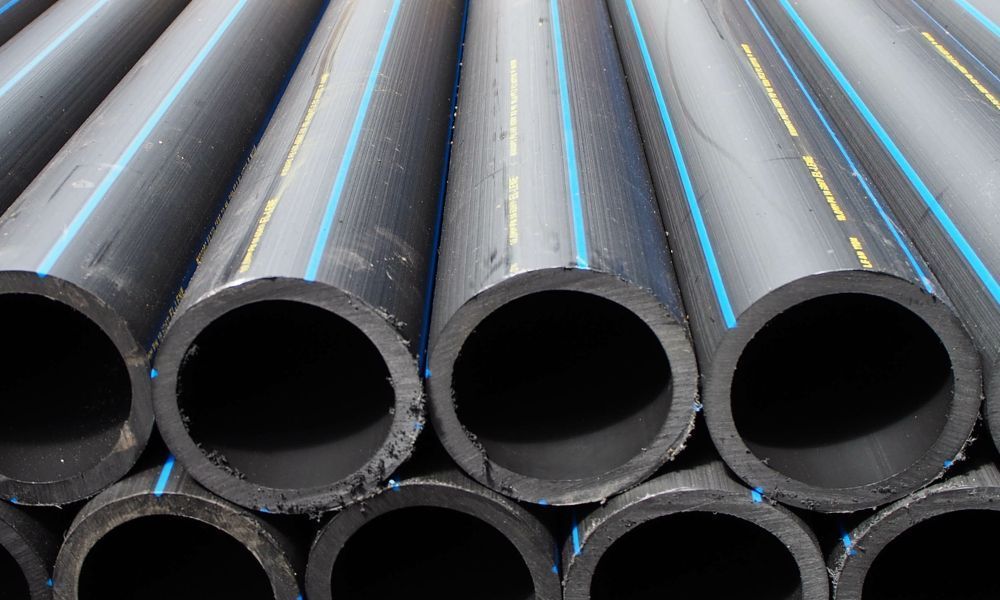High-density polyethylene (HDPE) pipe is outstanding in many applications thanks to its efficient delivery capabilities. The flexible material can replace traditional pipes and last a long time! Discover the ins and outs of HDPE by reading this guide to the different types of HDPE pipe.
What Is HDPE Pipe?
HDPE pipe is flexible plastic made of thermoplastic high-density polyethylene. A common use is transferring low-temperature fluid and gas. However, chemical and corrosion-resistant pipes often replace aging concrete or steel pipeline mains.
High-density polyethylene is a synthetic polymer that comes from petroleum. The pipe’s molecular bond makes it suitable for high-pressure pipelines. Modern uses include carrying hazardous waste, stormwater, and various gases.
Quick History of HDPE Pipe
The first polyethylene (PE) pipe was produced in 1933. Unfortunately, the manufacturing costs were extremely high, and chemists needed to discover innovative ways to reduce costs while achieving better profits. There was a breakthrough after 20 years.
A chemist at Phillips Petroleum Co. created the first HDPE pipe in the 1950s. Manufacturers initially used HDPE material to create baby bottles since it was safe (and didn’t break like glass).
During the late 1950s, HDPE pipe took over the functions of metal pipes in gas systems. Throughout the 1960s–1980s, manufacturers integrated these pipes in construction and conduit systems.
Today, HDPE is a thermoplastic resin with optimal performance capabilities. After evolving from its origins of replacing glass baby bottles, the material is common for piping, metal bails, gas tanks, and much more.
Why Is HDPE Pipe Superior?
Because they have excellent characteristics while being cost-effective, HDPE pipe can replace traditional systems. Let’s learn why HDPE pipe is superior.
Chemical and Corrosion Resistant
HDPE pipe is resistant to chemicals that could corrode weaker materials. It’s important to know that these pipes are chemically inert and don’t conduct heat or electricity. They can’t create an environment that allows chemical reactions to take place, preventing situations that would decrease performance and longevity.
Temperature Friendly
The pipes are suitable for hot or cold water in various environments. HDPE pipe can handle environmental temperatures ranging from -40 degrees Fahrenheit to 140 degrees Fahrenheit. Additionally, the pipes manage freeze and thaw cycles without sustaining damage.
Cost-Effective
HDPE pipe is less expensive than traditional pipe materials. The pipes are lightweight and easy to handle, which cuts material handling and installation costs. HDPE pipe can replace concrete pipes in sewer systems. Concrete pipes can crack and burst, but HDPE eliminates this possibility, ultimately saving time and money.
Durable
High-density polyethylene is durable and resistant to damage from external loads, pressure surges, or vibrations. The pipes should last from 50 to 100 years because they offer high-impact, chemical, and water resistance. The material doesn’t break down like traditional piping, and its lightweight nature adds to a long lifespan.
Lightweight and Flexible
HDPE pipe has solid, straight, or flexible coiled lengths. Their lightweight materials are easy to transport and don’t require heavy equipment for installation. Polyethylene pipes have a bend radius of up to 20 times the pipe’s diameter, allowing them to conform to unique installation paths without breaking. Additionally, the pipes are not brittle!
Types of HDPE Pipe
The physical and mechanical properties of HDPE pipe include density, yield strength, elongation, hardness, and elastic modulus. Manufacturers classify pipes into pressure grades, known as PN grades. It also includes the standard dimension ratio (SDR), which describes the correlation between the pipe dimension and the thickness of the wall.
Note that the type of HDPE pipe varies depending on the material that the system transfers and its density. Pipes sizes vary in thickness, diameter, and length. Manufacturers can customize pipes for specific applications. There are several different types of HDPE pipe. You can refer to pressure rating charts for an in-depth look at different pipes.
HDPE 80 and HDPE 100 are the main types of HDPE pipe. HDPE 80 pipes transport gas, and HDPE 100 pipes transport liquids like oil and water. HDPE 100 pipes offer higher density for extra durability. They also work under high operating temperatures, making them the most popular!
Pressure Rating Chart
A pressure rating chart lets you classify HDPE pipe systems. Here are common pressures to consider:
- PE 32 – low-pressure piping
- PE 40 – low-pressure piping
- PE 63 – medium-pressure piping
- PE 80 – gas pipe for natural gas distribution
- PE 100 – high-demand piping applications
HDPE Pipe Applications
Several industries use HDPE pipe for specific purposes. The long-lasting and robust material is ideal for many piping systems. Here are some typical applications:
Industrial
High-density polyethylene is common for domestic sewage systems, sewer effluent control, and water purification in sanitary systems. HDPE pipe transports chemicals and filters water in the petrochemical industry.
Agriculture
HDPE pipe is ideal for irrigation in water supply systems and suction lines. Since the pipes are corrosion and chemical resistant, they don’t experience soil corrosion, making them suitable for irrigation and drainage.
Aquaculture
Industries use HDPE pipe for supply lines and floats. The pipes withdraw large volumes of water from various water bodies. They can also serve as cages for planting, seeding, and grading. Some companies use the cages for fish farms.
Mining
The mining industry uses HDPE pipe for surface and underground operations and slurries. The pipes typically transport fluids and chemicals but are also useful for mine dewatering in open mine operations.
Building
Residential and commercial buildings also experience the benefits of HDPE pipe. Builders use the pipes in cold water reticulation systems and to provide ducting for air-conditioning and refrigeration.
Civil Engineering
Companies use HDPE pipe in water mains, service pipes, and sewer reticulation systems. They are also popular conduits for cables in electrical systems.
How Does HDPE Pipe Stick Together?
HDPE pipe and fittings come together by welding or with mechanical fittings. The two types of welding methods are electrofusion welding and butt-welding.
Electrofusion permanently joins individual pipes and fittings or prefabricated sections in tight areas. This method is appropriate for on-site joints.
Butt-welding joins HDPE pipe and fittings into prefabricated sections using heat and pressure. Welders do this without using additional connection fittings.
Besides those two methods, socket welding and extrusion welding can join HDPE pipe. Regardless of the technique, welding pipes prevents weak and leaking joints.
Picking a Good Pipe Supplier
A good HDPE pipe supplier is essential in all applications. The right supplier can ensure high-quality pipes with low maintenance. Companies interested in suppliers should assess service records, cost, reputation, and volume output.
It’s best to ask suppliers about their quality control process. Visual inspections, material traceability, and density tests influence performance and longevity. Ultimately, companies need pipes from a hands-on supplier that prioritizes quality assurance.
The Future of HDPE Pipe
You can expect HDPE pipe to replace cast iron, concrete, and steel in most piping and conduit systems. It will improve natural gas distribution, plumbing, underfloor heating, mining, and much more! HDPE pipe won’t slow down anytime soon!
Coastal Resource Group offers industrial products and services along with HDPE pipe. Our vacuum truck hoses are the right cleaning solutions for small or large spills. Purchase what you need today!



